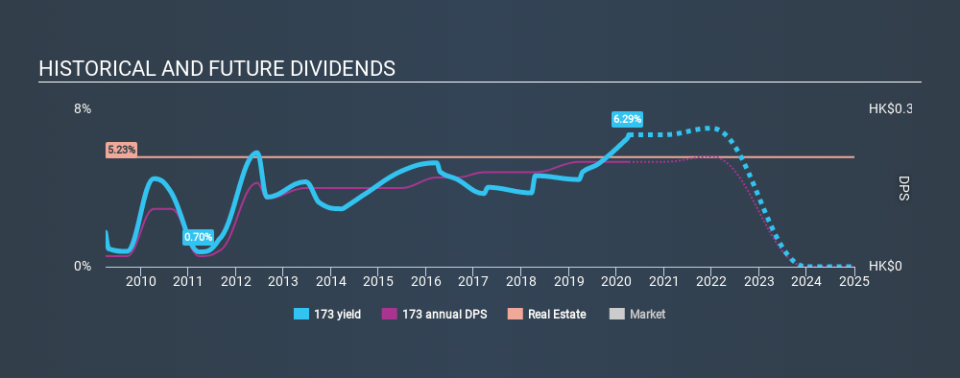Are You An Income Investor? Don't Miss Out On K. Wah International Holdings Limited (HKG:173)

Dividend paying stocks like K. Wah International Holdings Limited (HKG:173) tend to be popular with investors, and for good reason - some research suggests a significant amount of all stock market returns come from reinvested dividends. On the other hand, investors have been known to buy a stock because of its yield, and then lose money if the company's dividend doesn't live up to expectations.
A high yield and a long history of paying dividends is an appealing combination for K. Wah International Holdings. It would not be a surprise to discover that many investors buy it for the dividends. There are a few simple ways to reduce the risks of buying K. Wah International Holdings for its dividend, and we'll go through these below.
Click the interactive chart for our full dividend analysis
Payout ratios
Companies (usually) pay dividends out of their earnings. If a company is paying more than it earns, the dividend might have to be cut. Comparing dividend payments to a company's net profit after tax is a simple way of reality-checking whether a dividend is sustainable. In the last year, K. Wah International Holdings paid out 20% of its profit as dividends. With a low payout ratio, it looks like the dividend is comprehensively covered by earnings.
Remember, you can always get a snapshot of K. Wah International Holdings's latest financial position, by checking our visualisation of its financial health.
Dividend Volatility
One of the major risks of relying on dividend income, is the potential for a company to struggle financially and cut its dividend. Not only is your income cut, but the value of your investment declines as well - nasty. K. Wah International Holdings has been paying dividends for a long time, but for the purpose of this analysis, we only examine the past 10 years of payments. This dividend has been unstable, which we define as having been cut one or more times over this time. During the past ten-year period, the first annual payment was HK$0.02 in 2010, compared to HK$0.20 last year. This works out to be a compound annual growth rate (CAGR) of approximately 26% a year over that time. The dividends haven't grown at precisely 26% every year, but this is a useful way to average out the historical rate of growth.
K. Wah International Holdings has grown distributions at a rapid rate despite cutting the dividend at least once in the past. Companies that cut once often cut again, but it might be worth considering if the business has turned a corner.
Dividend Growth Potential
With a relatively unstable dividend, it's even more important to see if earnings per share (EPS) are growing. Why take the risk of a dividend getting cut, unless there's a good chance of bigger dividends in future? Earnings have grown at around 8.9% a year for the past five years, which is better than seeing them shrink! A low payout ratio and strong historical earnings growth suggests K. Wah International Holdings has been effectively reinvesting in its business. We think this generally bodes well for its dividend prospects.
Conclusion
Dividend investors should always want to know if a) a company's dividends are affordable, b) if there is a track record of consistent payments, and c) if the dividend is capable of growing. Firstly, we like that K. Wah International Holdings has a low and conservative payout ratio. Next, earnings growth has been good, but unfortunately the dividend has been cut at least once in the past. K. Wah International Holdings has a credible record on several fronts, but falls slightly short of our standards for a dividend stock.
Market movements attest to how highly valued a consistent dividend policy is compared to one which is more unpredictable. However, there are other things to consider for investors when analysing stock performance. For instance, we've picked out 3 warning signs for K. Wah International Holdings that investors should take into consideration.
Looking for more high-yielding dividend ideas? Try our curated list of dividend stocks with a yield above 3%.
If you spot an error that warrants correction, please contact the editor at editorial-team@simplywallst.com. This article by Simply Wall St is general in nature. It does not constitute a recommendation to buy or sell any stock, and does not take account of your objectives, or your financial situation. Simply Wall St has no position in the stocks mentioned.
We aim to bring you long-term focused research analysis driven by fundamental data. Note that our analysis may not factor in the latest price-sensitive company announcements or qualitative material. Thank you for reading.


